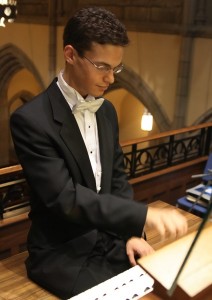ECCLES ORGAN FESTIVAL, Nathan Laube, organ, Cathedral of the Madeleine, Sept. 8
To open the 20th anniversary season of the Eccles Organ Festival last Sunday, the Cathedral of the Madeleine invited the young American organist Nathan Laube. Making his Salt Lake City debut, Laube played a wonderfully vibrant and versatile program that brought together Jean-Philippe Rameau and J.S. Bach, two giants of the baroque, and Felix Mendelssohn and Franz Liszt, two of the undisputed masters of German romanticism.
Laube, who teaches at the Eastman School, is quickly becoming a much sought after concert artist around the world. His playing Sunday demonstrated quite clearly why he is one of the emerging stars of the organ. Laube has the perfect blend of imposing technique and refined musicality. His interpretative skills are impressive as is his range of expressions. He is a very articulate and perceptive artist who brings depth and perspective to his performances and makes the music come alive.
Laube opened his program with a majestic account of the Chaconne from Rameau’s opera Les Indes Galantes. He followed that with Bach’s glorious Partita on the chorale Sei gegrüsset, Jesu gütig, BWV 768. One of the most imposing works for organ by Bach, the partita demands a great deal from the player in terms of expression and articulation. And Laube delivered a wonderfully perceptive and sensitive performance that brought out the rich lyricism and deep emotions that lie at the core of the work.
The first half concluded with Laube’s own transcription of Mendelssohn’s dark Variations Serieuses. Laube turned the challenging solo piano piece into a virtuosic organ work that captured the lyricism and drama of the original. His account was nuanced and wonderfully expressive.
The final work on the program was Liszt’s massive Fantasy and Fugue on the chorale Ad nos, ad salutarem undam. The work is symphonic in its scope, textures, dynamics and themes and unmistakably Lisztian in its chromaticism and diffuse harmonies. It’s a bold and uncompromising work in many ways, not the last of which in its exploration of the organ’s possibilities.
It also tests the stamina of the organist. Laube was more than up to the demands of this piece and gave a tour de force performance that captured the richness, expressiveness, breadth and depth of the music. His account was articulate, nuanced and subtle (as much as Liszt allows the performer to be subtle). Laube never let himself be swayed by the at times bombastic character of the work. His interpretation was well conceived and executed.
The festival runs through Nov. 3. Below is a schedule of the remaining concerts. Performances begin at 8 p.m. and are free of charge. Unless otherwise noted, concerts are held in the Cathedral of the Madeleine.
- Sept. 22: “Organ-Plus,” music for organ and other instruments, with organists Douglas Bush and Kenneth Udy. (Cathedral Church of St. Mark, 231 E. 100 South)
- Oct. 6: Jean-Baptiste Robin, organist at the Chapelle Royale du Château de Versailles, France.
- Oct. 20: Dongho Lee, organist at Christ Church, Charlotte, North Carolina.
- Nov. 3: Isabelle Demers, professor of organ at Baylor University, Waco, Texas.

